

The Parts of Human Speech Organs & Their Definitions

Types of Phonetics
Imagine being unable to verbally respond to a verbal greeting. Thinking about the ability to speak as an important part of your day may not cross your mind. If that speech ability was taken away, you might find yourself unable to communicate not only basic speech but also emotional responses like fear, confusion or anxiety. Although you may not give your speech organs much thought, they are integrally tied to how you function. From the lungs to the mouth, the organs of speech and their function in sound production and speech play important roles in many aspects of your life.
Breathing and Speaking Connections
Looking at the speech mechanism and organs of speech begins with the vital lungs. The lungs are located in the chest cavity and expand and contract to push air out of the mouth. Simple airflow is not enough to produce speech. The airflow must be modified by other speech organs to be more than just respiration. When you exhale, air moves out of your lungs through your windpipe or trachea. At the top of the trachea is one of the other primary organs of speech: the larynx or voice box.
Vibrations of the Larynx
Three more parts of the speech mechanism and organs of speech are the larynx, epiglottis and vocal folds. The larynx is covered by a flap of skin called the epiglottis. The epiglottis blocks the trachea to keep food from going into your lungs when you swallow. Across the larynx are two thin bands of tissue called the vocal folds or vocal cords. Depending on how the folds are positioned, air coming through the trachea makes them vibrate and buzz. These vibrations are called a "voiced" or soft sound. Placing finger tips over the Adam's apple or larynx at the front of your neck while humming makes it possible to feel the vocal fold vibration.
Articulators of Speech
The inside of your mouth is also called the oral cavity and controls the shape of words. At the back of the oral cavity on the roof of the mouth is the soft palate or velum. When you pronounce oral sounds, such as "cat" or "bag," the velum is located in the up position to block air flow through the nasal cavity. When you pronounce nasal sounds, such as "can" or "mat," the velum drops down to allow air to pass through the nasal cavity. In front of the velum is the hard palate. Your tongue presses or taps against the hard palate when you pronounce certain words, such as "tiptoe." Developmental or physical issues related to speech organs that are articulators of speech can result in a need for speech therapy.
Teeth, Tongue and Lips
Say "Thank you." Feel how your tongue presses against the inside of your front teeth. The convex area directly behind your teeth is known as the teeth ridge. For the purpose of linguistics, the tongue is divided into three regions: the blade, front and back. The tip of the tongue, which touches the teeth ridge, is called the blade. The middle of the tongue, which lines up with the hard palate, is called the front of the tongue. Finally, beneath the soft palate is the back of the tongue. The final speech organ is the most visible and obvious: the lips. Your lips influence the shape of the sounds leaving the oral cavity. Each of these organs of speech and their definitions is important to the process of speech, articulation and expressions through sounds.
Related Articles

How to Transcribe Words Into IPA Format

How to Articulate for Effective Speaking

Medical Terminology Exercises

Examples of Diffusion in Organs

How to Teach Kids About Germs & Hygiene

How to Encode & Decode a Communication Model

Effective Uses of Verbal Communication
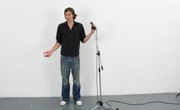
Speech Techniques for High School
- The University of Iowa: Three Parts of Speech
- Aston University: How Sound is Produced
- The Scientist: Why Human Speech is Special
Carolyn Robbins began writing in 2006. Her work appears on various websites and covers various topics including neuroscience, physiology, nutrition and fitness. Robbins graduated with a bachelor of science degree in biology and theology from Saint Vincent College.

Literature and Humanities
literature simplified and made lively
The Organs of Speech
There are a lot of organs which help a person speak with proper pronunciation and clarity. Some organs are helpful in differentiating the sounds through articulation.
They act as the main source of energy for speech. It has small air pockets called alveoles in which oxygen is stored. When the air in the alveolus is pushed up, the displaced air comes up the windpipe (trachea) and reaches the larynx. The air passes through the larynx and reaches pharynx. By adjusting the various parts in the mouth different speech sounds are produced before the lung air goes out into the atmosphere either through the mouth (oral passage) or the nose (nasal passage).
It is the protruding part of the throat commonly called Adam’s apple. It is also known as the soundbox of the body.
Vocal cords
They are two elastic strips placed across the larynx facing each other. They are fixed at one end (far end) and free at the other. In the case of normal breathing, the vocal cords are drawn apart leaving a gap between them through which the air passes freely from the lungs. This gap between the vocal cords is known as glottis. Sometimes while speaking, the vocal cords are brought into contact with each other gently. In this position, the air from the lungs pushes through these vocal cords setting them in vibration. Speech sounds that are produced with the vocal cords vibrating are known as voiced sounds, e.g. /z/. sometimes, speech sounds are produced with the vocal cords, not in contact with each other and hence not vibrating such speech sounds which are known as voiceless sounds. E.g. /s/
Glottal Stop /p/
It happens when the vocal cords are brought into contact with each other rather firmly and thus stopping the air from passing through them.
The two lips are flexible organs of speech. They can combine with each other to produce certain sounds, e.g. /p, b/. sometimes the lower lip can combine with upper front teeth to produce certain sounds, e.g. /f, v/
The Roof of the Mouth
It consists of the upper front teeth, alveolar ridge, palate or hard palate and soft palate.
The upper front teeth are fixed part of speech. The upper front teeth can combine with the lower lip to produce some sounds like /f, v/. they can also combine with the tongue to produce certain sounds like /ð/ as in this, either, θ as in thing, myth .
Alveolar Ridge
It is a hard, bulging, bony part found immediately behind the upper front teeth. This can combine with the tongue to produce certain sounds like /l, t, n/
It is also known as a hard palate.it is the hard-concave part of the roof of the mouth. Sometimes it can combine with the tongue to produce certain sounds, e.g. /j/
Soft Palate
It is soft, loosely hanging, the fleshy part after the hard palate. This can be in 3 positions.
- In between the wall of the mouth and back of the tongue. This is the position of the soft palate in the case of normal breathing. This position is also known as a neutral position. It can be raised sufficiently to be in firm contact with the wall of the mouth. Then the nasal passage is completely blocked, and all the lung air passes out only through the oral passage (mouth).
- It can also be lowered sufficiently to be in firm contact with the back of the tongue. Thus, the oral passage is completely locked and all the air from the lung passes out only through the nasal passage (nose).
- Certain sounds are produced with soft palate and the tongue combining with each other. E.g. /k, g/. the tip of the soft palate is called vellum.
It is the most flexible part; the prime organ of speech. The tongue is divided into 4 parts namely, the tip, the blade, the front, and the back. The tip of the tongue can move in the direction of the back part of the upper front teeth in the production of certain sounds. / ð, θ/
It can combine with the alveolar ridge to produce certain sounds, /t, s, n/
The front of the tongue can combine with the hard palate to produce certain sounds, /I, i:, j/
The back of the tongue combines with the soft palate to produce certain sounds, /k/.
Share this:
Leave a comment, cancel reply.
Your email address will not be published. Required fields are marked *
The English Language Today, Yesterday, Tomorrow
Workbook & supplementary exercises.
Daniel Donoghue [email protected]

Diagram of the organs of speech
The organs of speech are shown on the diagram below. Learn their names and locations, and be prepared to write the names into a blank diagram.
Visible Human Viewer The Visible Human Viewer lets you scroll through photographic cross-sections of the human head along different axes. Try to identify the organs in the diagram in the photographs of the VHV.

- Lesson Plans
- Technology in Education
Welcome to the Visible Body Blog!
© 2024 Visible Body

Something to Talk About: The Anatomy of Speech Sounds
Posted on 2/21/19 by Laura Snider
When it comes to communication, humans are pretty unique. Our mouths and throats are specialized to create a wide array of sounds, and the fact that we string those sounds together to transfer thoughts from one brain to another is a pretty impressive feat in the animal kingdom. One thing I found on the path to my master’s degree in linguistics is that the more you learn about humans’ language capabilities, the more you feel awed by just how amazing they are!
How do our vocal tracts produce the range of sounds used in human language? What are the biological underpinnings of speech production? Stay tuned to find out.
A Tour of the Vocal Tract
The pathway air takes from our lungs to the outside world isn’t just a smooth, featureless tube. That would actually be pretty weird. Instead, the vocal tract is full of lots of muscles and structures that can obstruct the stream of air at various points along its journey, creating the sounds that make up the languages we speak.
A brief video introduction to the vocal tract! Footage from Human Anatomy Atlas 2019 .
When we exhale, air travels from the lungs up into the trachea. The first place where we can start messing with the air stream is the larynx, which is perched at the top of the trachea. We can contract muscles in the larynx to manipulate bands of tissue called the vocal cords (or vocal folds). The vibration of the vocal cords is called phonation .

By regulating the tension of the vocal cords and changing the amount of space between them (the glottis), we can modulate the pitch, volume, and tonal quality of our voices. There is a continuum of phonation types , from whispering to “creaky voice” (similar to vocal fry ).
We can also completely stop the stream of air by fully closing the distance between the vocal folds. This gives us the glottal stop (think of the sound you make between the syllables of “uh-oh”).
Next, let’s talk about the tongue. The tongue is made up of four intrinsic muscles: the superior lingualis, inferior lingualis, vertical lingualis, and transverse lingualis. There are also four extrinsic tongue muscles that help the tongue move: the genioglossus, hyoglossus, palatoglossus, and styloglossus.
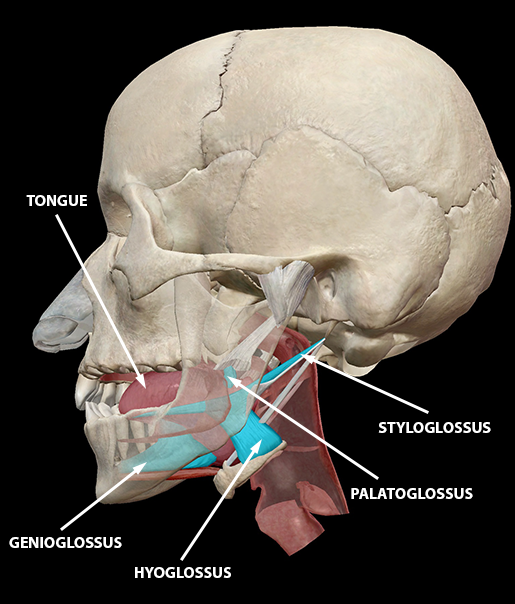
The tongue is one of the most active of the articulators in the vocal tract. It can impede the flow of air by coming in contact with the oropharyngeal wall, soft palate (velum), hard palate, and alveolar ridge (the part of the hard palate just behind the front teeth).
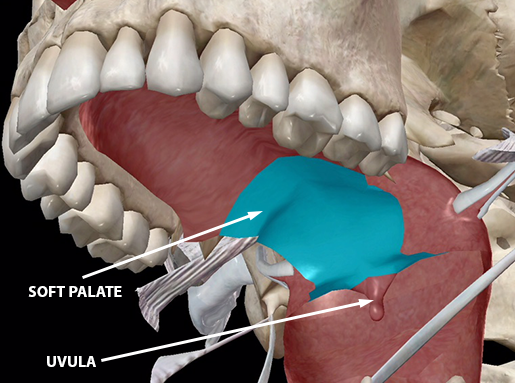
It’s no wonder that the tongue has so many muscles helping it out—it needs to be pretty versatile to make the specific movements required for speech! Movements of the mouth, face, tongue, and larynx are so important, in fact, that a large portion of the primary motor cortex is devoted to them.
You might recognize the image below (the motor homunculus) from the neuromuscular interaction article from a few weeks back. The face/tongue/larynx and hands are depicted as the largest parts of the body in the homunculus representation because of the large regions of motor cortex devoted to their intricate motions.
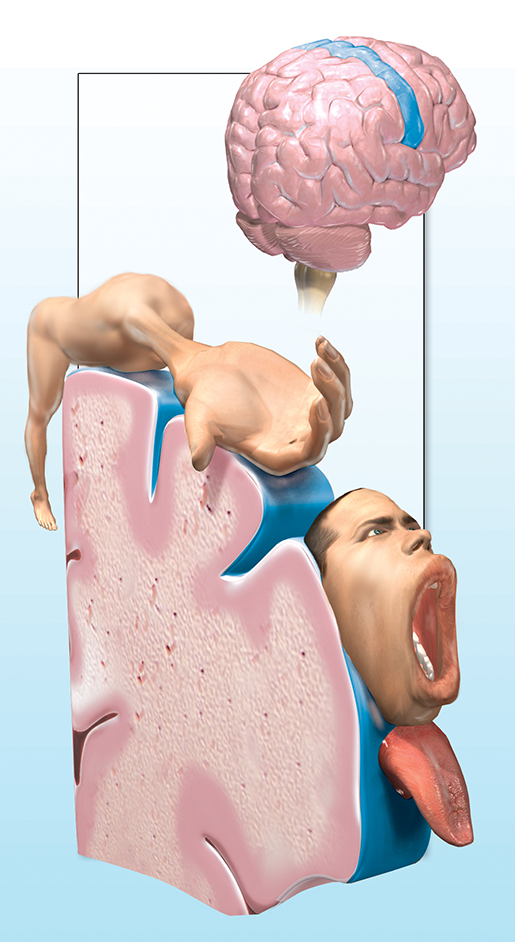
Speech Sounds: Let's Make Some Noise!
Now we’re going to put all the muscle-y stuff together with some linguistics to give a more complete picture of how the motions of your articulators create particular sounds.
Phoneticians (linguists who study the articulatory and/or acoustic properties of speech sounds) have grouped the speech sounds humans make into several categories. There are vowels and consonants, of course, but there are also lots of smaller distinctions within those categories.
Let’s start with vowels. Vowels don’t involve stopping the stream of air as it travels up from the lungs, but they do involve changing the shape and size of the space through which the air passes. The vocal cords must also be vibrating in order for a vowel sound to be produced. If you’re an English speaker, try going through the vowel sounds “ah” “ey” “ee” “oh” and “ooh” and pay attention to how the shape of your lips and the amount of space inside your mouth changes. Vowel sounds can also combine to form diphthongs .
Linguists typically group vowels based on their tongue height (high, mid, low), tension (tense, lax), and tongue position (front, central, back) as well as whether the lips are rounded.
In contrast, a consonant is basically any sound that isn’t a vowel. They involve stopping the flow of air, either fully or partially, and releasing it again. Consonants are categorized by their place and manner of articulation.
The place of articulation refers to the point at which the airflow is impeded. This can occur at the lips, teeth, alveolar ridge, hard palate, soft palate, uvula, oropharyngeal wall, epiglottis, and glottis. Much of the time, the tongue is responsible for blocking the air stream, but glottal, epiglottal, bilabial (lips are pressed together), and labiodental (top teeth press against bottom lip) sounds are notable exceptions to this generalization.
The manner of articulation refers to what happens to the air. Stop consonants (p, b, t, d, k, hard g) completely obstruct the flow of air before releasing it again. Fricatives (like s or f) create a narrow space for air to pass through, giving them a hissing sound. Affricates (ch, j) are roughly between a stop and a fricative. Approximants (r, l, w, y) involve articulators coming close enough together to qualify as a consonant rather than a vowel, but no friction is created.
Nasal sounds (like English n, m, and ng) are not your average consonants. Basically, airflow is blocked in the mouth, as in a stop consonant, but the air is allowed to flow out through the nasal cavity because the velum (soft palate) is lowered.
Pathologies
When we string sounds and syllables into words and phrases, the primary motor cortex works together with regions of the brain, such as Broca’s area (BA 44–45), that deal with computational aspects of language production. Damage to Broca’s area results in expressive aphasia ( Broca’s aphasia ), which is characterized by patients having difficulty producing fluent speech, especially when complex grammar is required.
There are also a number of pathologies that can affect the articulatory/neuromuscular component of speech production.
One of these is dysarthria , in which neurological damage from stroke, traumatic brain injury, or degenerative disorders (ALS, MS, Dementia) makes it difficult to move the muscles that produce speech sounds. This is due to a disruption in the transmission of motor signals from the brain to the articulators. Direct damage to the speech organs can result in a condition called peripheral dysarthria. Typical symptoms of dysarthria include speech that is too fast or slow, slurred, or mumbled. People with dysarthria may also have trouble moving their jaw, tongue, or lips.
Another condition affecting speech articulation is a developmental disorder called childhood apraxia of speech (CAS) . Potential causes for CAS can include (but are not limited to) brain damage or underlying genetic conditions. Unlike dysarthria, CAS does not involve muscle weakness. Children with CAS do still have trouble moving their muscles to make speech sounds, but this problem lies more with motor planning than disruptions in the transmission of signals from brain to muscle. Whew! That was a lot of sounds. And just think—every time you speak, your brain and muscles coordinate the required movements at lightning speed! What’s more, the sounds of English are only a piece of the full sound inventory of the world’s languages. Check out UCLA’s phonetics archive to learn more (you can listen to just about any type of speech sound on this site—it’s awesome!).

Be sure to subscribe to the Visible Body Blog for more anatomy awesomeness!
Are you a professor (or know someone who is)? We have awesome visuals and resources for your anatomy and physiology course! Learn more here. Additional Sources:
Phonation Types
Cortical Language Areas
Evolution of the Vocal Tract
Human vs. Ape Vocal Tracts
Human Vocal Tract & Child Language Development
- Anatomy & Physiology
Get free instructor access to Courseware
Subscribe to the visible body blog, most popular.

For students
For instructors
Get our awesome anatomy emails!
When you select "Subscribe" you will start receiving our email newsletter. Use the links at the bottom of any email to manage the type of emails you receive or to unsubscribe. See our privacy policy for additional details.
- Teaching Anatomy in 3D
- Teaching Biology in 3D
- Webcasts & Demos
- For K-12 Instructors
- K-12 Funding Guide
- Premade Courses
- Anatomy Learn Site
- Biology Learn Site
- Visible Body Blog
- eBooks and Lab Activities
- Premade Tours
- Premade Flashcard Decks
- Customer Stories
- Company News
- Support Site
- Courseware FAQ
- Submit a Ticket
©2024 Visible Body. All Rights Reserved.
- User Agreement
- Permissions
Chapter 11.2: Speech Organs

Chapter 11.2 The organs of speech
When we speak, we use our vocal tracts to produce sounds, or phones. Before examining the sounds we make in English, it is helpful to understand what these organs are and how they are used.
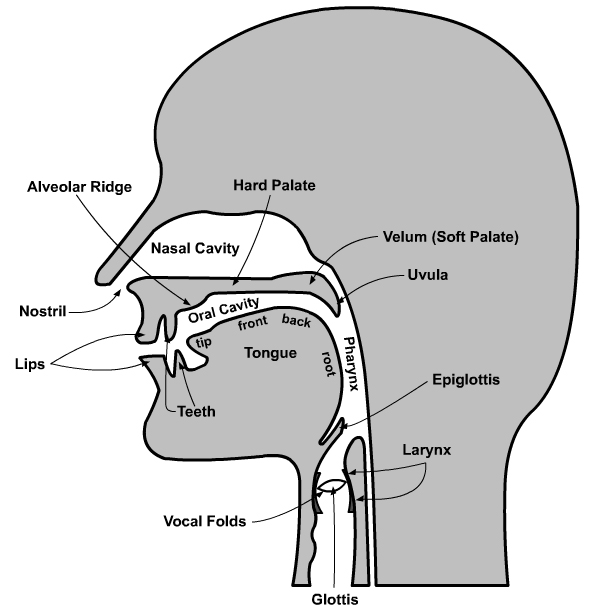
In English, almost all sounds are made by obstructing the air in some way as it passes through the oral cavity. Air is expelled from the lungs, up through the glottis, past the vocal cords. The vocal cords are two thin membranes that stretch across the larynx. They open when we breath, but they vibrate against each other when we make certain sounds (called “voiced” sounds), as you can see in the following videos:
Once the air has passed the vocal cords, it is restricted or obstructed, often by some part of the tongue as it is placed near or against various parts of the oral cavity. These places include the lips, the teeth, the hard alveolar ridge directly behind the teeth, the long, concave roof of the mouth, called the palate or sometimes the hard palate, and then the velum, also called the soft palate. For most sounds the velum closes the passage into the nasal cavity, but for nasal sounds the passage is left open so that air can resonate there.
In this video of two people, an opera singer and a beat boxer, you can see how the speech organs move to create different sounds. As you watch, concentrate on the movements of the tongue — notice where and how it hits against various parts of the mouth, or how it shapes itself to produce different vowels. After completing the entire section on phonology, you might want to come back and watch it again.
- Increase Font Size
6 Mechanism of Speech Production
Dr. Namrata Rathore Mahanta
Learning outcome:
This module shall introduce the learner to the various components and processes that are at work in the production of human speech. The learner will also be introduced to the application of speech mechanism in other domains such as medical sciences and technology. After reading the module the learner will be able to distinguish speech from other forms of human communication and will be able to describe in detail the stages and processes involved in the production of human speech.
Introduction : What is speech and why it an academic discipline?
Speech is such a common aspect of human existence that its complexity is often overlooked in day to day life. Speech is the result of many interlinked intricate processes that need to be performed with precision. Speech production is an area of interest not only for language learners, language teachers, and linguists but also people working in varied domains of knowledge. The term ‘speech’ refers to the human ability to articulate thoughts in an audible form. It also refers to the formal one sided discourse delivered by an individual, on a particular topic to be heard by an audience.
The history of human existence and enterprise reveals that ‘speech’ was an empowering act. Heroes and heroines in history used ‘speech’ in clever ways to negotiate structures of power and overcome oppression. At times when the written word was an attribute of the elite and noble classes ‘speech’ was the vehicle which carried popular sentiments. In adverse times ‘speech’ was forbidden or regulated by authority. At such times poets and ordinary people sang their ‘speech’ in double meaning poems in defiance to authority. In present times the debate on an individual’s ‘right to free speech’ is often raised in varied contexts. As an academic discipline Speech Communication gained prominence in the 20th century and is taught in university departments across the globe. Departments of Speech Communication offer courses that engage with the speech interactions between people in public and private domain, in live as well as technologically mediated situations.
However, the student who peruses a study of ‘mechanism of speech production’ needs to focus primarily on the process of speech production. Therefore, the human brain and the physiological processes become the principal areas of investigation and research. Hence in this module ‘speech’ is delimited to the physiological processes which govern the production of different sounds. These include the brain, the respiratory organs, and the organs in our neck and mouth. A thorough understanding of the mechanism of speech production has helped correct speech disorders, simulate speech through machines, and develop devices for people with speech related needs. Needless to say, teachers of languages use this knowledge in the classroom in a variety of ways.
Speech and Language
In everyday parlance the terms ‘speech’ and ‘language’ are often used as synonyms. However, in academic use these two terms refer two very different things. Speech is the ‘spoken’ and ‘heard’ form of language. Language is a complex system of reception and expression of ideas and thoughts in verbal, non-verbal and written forms. Language can exist without speech but speech is meaningless without language. Language can exist in the mind in the form of a thought, on paper/screen in its orthographic form; it can exist in a gesture or action in its non-verbal form, it can also exist in a certain way of looking, winking or nodding. Thus speech is only a part of the vast entity of language. It is the verbal form of language.
Over the years Linguists have engaged themselves with the way in which speech and language exists within the human beings. They have examined the processes by which language is acquired and learnt. The role of the individual human being, the role of the society/community/the genetic or physiological attributes of the human beings all been investigated from time to time.
Ferdinand de Saussure a Swiss linguist who laid the foundation for Structuralism declared that language is imbibed by the individual within in a society or community. His lectures delivered at the University of Geneva during 1906-1911 were later collected and published in 1916 as Cours de linguistique générale . Saussure studied the relationship between speech and the evolution of language. He described language as a system of signs which exists in a pattern or structure. Saussure described language using terms such as ‘ langue ’ ‘ parole ’ and ‘langage ’. These terms are complex and cannot be directly translated. It would be misleading to equate Saussure’s ‘ langage ’ with ‘language’. However at an introductory stage these terms can be described as follows:
American linguist Avram Noam Chomsky argued that the human mind contains the innate source of language and declared that humans are born with a mind that is pre-programmed for language, i.e., humans are biologically programmed to use languages. Chomsky named this inherent human trait as ‘Innate Language’. He introduced two other significant terms: ‘Competence’ and ‘Performance’
‘Competence’ was described as the innate knowledge of language and ‘Performance’ as its actual use. Thus the concepts of ‘Innate Language’ ‘Language Competence’ and ‘Language Performance’ emerged and language came to be accepted as a cognitive attribute of humans while speech came to be accepted as one of the many forms of language communication. These ideas can be summarized in the chart given below:
In the present times speech and language are seen as interdependent and complementary attributes of humans. Current research focuses on finding the inner connections between speech and language. Consequently, the term ‘Speech and Language’ is used in most application based areas.
From Theory to Application
It is interesting to note that the knowledge of the intricacies of speech mechanism is used in many real life applications apart from Language and Linguistics. A vibrant area in Speech and Language application is ‘Speech and Language Processing’. It is used in Computational Linguistics, Natural Language Processing, Speech Therapy, Speech Recognition and many more areas. It is used to simulate speech in robots. Vocoders and Text to speech function (TTS) also makes use of speech mechanism. In Medical Sciences it is used to design therapy modules for different speech and language disorders, to develop advanced gadgets for persons with auditory needs. In Criminology it is used to recognize speech patterns of individuals and to identify manipulations in recorded speech patterns. Speech processing mechanism is also used in Music and Telecommunication in a major way.
What is Speech Mechanism?
Speech mechanism is a function which starts in the brain, moves through the biological processes of respiration, phonation and articulation to produce sounds. These sounds are received and perceived through biological and neurological processes. The lungs are the primary organs involved in the respiratory stage, the larynx is involved in the phonation stage and the organs in the mouth are involved in the articulatory stage.
The brain plays a very important role in speech. Research on the human brain has led to identification of certain areas that are classically associated with speech. In 1861, French physician Pierre Paul Broca discovered that a particular portion of the frontal lobe governed speech production. This area has been named after him and is known as Broca’s area. Injury to this area is known to cause speech loss. In 1874, German neuropsychiatrist Carl Wernicke discovered that a particular area in the brain was responsible for speech comprehension and remembrance of words and images. At a time when brain was considered to be a single organ, Wernicke demonstrated that the brain did not function as a single organ but as a multi pronged organ with distinctive functions interconnected with neural networks. His most important contribution was the discovery that brain function was dependent on these neural networks. Today it is widely accepted that areas of the brain that are associated with speech are linked to each other through complex network of neurons and this network is mostly established after birth, through life experience, over a period of time.
It has been observed that chronology and patterning of these neural networks differ from individual to individual and also within the same individual with the passage of time or life experience. The formation of new networks outside the classically identified areas of speech has also been observed in people who have suffered brain injury at birth or through life experience. Although extensive efforts are being made to replicate or simulate the plasticity and creativity of the human brain, complete replication has not been achieved. Consequently, complete simulation of human speech mechanism remains elusive.
The organs of speech
In order to understand speech mechanism one needs to identify the organs used to produce speech. It is interesting to note that each of these organs has a unique life-function to perform. Their presence in the human body is not for speech production but for other primary bodily functions. In addition to primary physiological functions, these organs participate in the production of speech. Hence speech is said to be the ‘overlaid’ function of these organs. The organs of speech can be classified according to their position and function.
- The respiratory organs consist of: The Lungs and trachea. The lungs compress air and push it up the trachea.
- The phonatory organs consist of the Larynx: The larynx contains two membrane- like structures called vocal cords or vocal folds. The vocal folds can come together or move apart.
- The articulatory organs consist of : lips, teeth, roof of mouth, tongue, oral and nasal cavities
The respiratory process involves the movement of air. Through muscle action of the lungs the air is compressed and pushed up to pass through the respiratory tract- trachea, larynx, pharynx, oral cavity, nasal cavity or both. While breathing in, the rib cage is expanded, the thoracic capacity is enlarged and lung volume is increased. Consequently, the air pressure in lungs drops down and the air is drawn into the lungs. While breathing out, the rib cage is contracted, the thoracic capacity is diminished and lung volume is decreased. Consequently, the air pressure in the lungs exceeds the outside pressure and air is released from the lungs to equalize it. Robert Mannel has explained the process through flowcharts and diagrammatic representations given below:
Once the air enters the pharynx, it can be expelled either through the oral passage, or through the nasal passage or through both depending upon the position of soft movable part of the roof of the mouth known as soft palate or velum.
Egressive and Ingressive Airstream: If the direction of the airstream is inward, it is termed as ‘Ingressive airstream. If the direction of the airstream is outward, it is ‘Egressive airstream’. Most languages of the world make use of Pulmonic Egressive airstream. Ingressive airstream is associated with Scandinavian languages of Northern Europe. However, no language can claim to use exclusively Ingressive or Egressive airstreams. While most languages of the world use predominantly Egressive airstreams, they are also known to use Ingressive airstreams in different situations. For extended list of use of ingressive mechanism you may visit Robert Eklund’s Ingressive Phonation and Speech page at www.ingressive.info .
Egressive process involves outward expulsion of air. Ingressive process involves inward intake of air. Egressive and Ingressive airstreams can be pulmonic (involving lungs) or non-pulmonic (involving other organs).
Non Pulmonic Airstreams: There are many languages which make use of non pulmonic airstream. In these cases the air expelled from the lungs is manipulated either in the pharyngeal cavity, or in the vocal tract, or in the oral cavity. Three major non pulmonic airstreams are:
In Ejectives, the air is trapped and compressed in the pharyngeal cavity by an obstruction in the mouth with simultaneous closure of the glottis. The larynx makes an upward movement which coincides with the removal of the obstruction causing the air to be released.
In Implosives, the air is trapped and compressed in the pharyngeal cavity by an obstruction in the mouth with simultaneous closure of the glottis. The larynx makes a downward movement which coincides with the removal of the obstruction causing the air to be sucked into the vocal tract.
In Clicks, the air is trapped and compressed in the oral cavity by lowering of the soft palate or velum and simultaneous closure of the mouth. Sudden opening causes air to be sucked in making a clicking sound. For a list of languages which use these airstream mechanisms you may visit https://community.dur.ac.uk/daniel.newman/phon10.pdf
While the process of phonation occurs before the airstream enters the oral or nasal cavity, the quality of speech is also determined by the state of the pharynx. Any irregularity in the pharynx leads to modification in speech quality.
The Phonatory Process: Inside the larynx are two membrane-like structures or folds called the vocal cords. The space between these is called the glottis. The vocal folds can be moved to varied distance. Robert Mannel has described five main positions of the vocal folds:
Voiceless: In this position the vocal folds are drawn far apart so that the air stream passes without any interference .
Breathy: Vocal folds are drawn loosely apart. The air passes making whisper like sound Voiced: Vocal folds are drawn close and are stretched. The air passes making vibrating sound.
Creaky : The vocal folds are drawn close & vibrate with maximum tension. Air passes making rough creaky sound. This sound is called ‘vocal fry’ and its use is on the rise amongst urban young women. However its sustained and habitual use is harmful.
For more details on laryngeal positions you may visit Robert Mannel’s page- http://clas.mq.edu.au/speech/phonetics/phonetics/airstream_laryngeal/laryngeal.html
You may see a small clip on the vocal fry by visiting the link – http://www.upworthy.com/what-is-vocal-fry-and-why-doesnt-anyone-care-when-men-talk- like-that
The Mouth The mouth is the major site for articulatory processes of speech production. It contains active articulators that can move and take different positions such as the tongue, the lips, the soft palate. There are passive articulators that cannot move but combine with the active articulators to produce speech. The teeth, the teeth ridge or the alveolar ridge, and the hard palate are the passive articulators.
Amongst the active articulators, the tongue can take the maximum number of positions and combinations to. Being an active muscle, its parts can be lowered or raised. The tongue is a major articulator in the production of vowel sounds. Position of the tongue determines the acoustics in the oral cavity during articulation of vowel sounds. For the purpose of identifying and describing articulatory processes, the tongue has been classified on two parameters.
a. The part of the tongue that is raised during the articulation process. There are four markers to classify the height to which the tongue is raised
- Maximum height
- Minimum height
- Two third of maximum height
- One third of maximum height
b. The height to which the tongue is raised during the articulation process. Three main parts of the tongue are identified as Front, Back, and Center.
For the purpose of description the positions of the tongue are diagrammatically represented through the tongue quadrilateral.
- Close: The Maximum height is called the high position or the close position. This is because the gap between the tongue and the roof of mouth is nearly closed.
- High-Mid or Half Close : Two third of maximum is called high- mid position or half – close position
- Low-Mid or Half Open : One third of maximum is called low – mid position or half- open position
- Low or Open : The Minimum height is called the Low or the Open position. This permits the maximum gap between the tongue and the roof of mouth.
The tongue also acts as an active articulator on the roof of the mouth to create obstruction in the oral cavity. Few prominent positions of the tongue are shown below
Lips: The lips are two strong muscles. In speech production the movement of the upper lip is less than that of the lower lip. The lips take different shapes: Rounded, Neutral or Spread
Teeth : The Upper Teeth are Passive Articulators.
The roof of the mouth:
The roof of the mouth has a hard portion and a soft portion which are fused seamlessly. The hard portion comprises of the Alveolar Ridge and the Hard Palate. The soft portion comprises of the Velum and the Uvula. The anterior part of the roof of the mouth is hard and unmovable. It begins from the irregular surface called alveolar ridge which lies behind the upper teeth. The alveolar ridge is followed by the hard palate which extends up to the centre of the tongue. The posterior part of the roof of the mouth is soft and movable. It lies after the hard palate and extends up to the small structure called the uvula.
The soft palate: It is movable and can take different positions during speech production.
- Raised position: In raised position the soft palate rests against the back of the mouth. The nasal passage is fully blocked and air passes through the mouth
- Lowered Position: In lowered position the soft palate rests against the back part of tongue in such a way that the oral passage is fully blocked and air passes through the nasal passage.
- Partially lowered Position: In partially lowered position, the oral as well as the nasal passages are partially open. Pulmonic air passes though the mouth as well as the nose to create ‘nasalized’ sounds.
The hard palate lies between the alveolar ridge and velum. It is a hard and unmovable part of the roof of the mouth. It lies opposite to the centre of the tongue and acts as a passive articulator against the tongue to produce sounds. Sounds produced with the involvement of the hard palate are called palatal sounds.
The alveolar ridge is the wavy part that lies just behind the teeth ridge opposite to the front of the tongue. It acts as a passive articulator against the tongue to produce sounds. Sounds produced with the involvement of the Alveolar ridge are called Alveolar sounds. Some sounds are created with the involvement of the posterior region of the Alveolar ridge. These sounds are called post alveolar sounds. Sometimes sounds are created with the involvement of the hindmost part of the alveolar ridge and the foremost part of the hard palate. Such sounds are called palato alveolar sounds.
Air stream mechanisms involved in speech production
The flow of air or the airstream is manipulated in a number of ways during production of speech. This is done with the movement of the active articulators in the oral cavity or the larynx. In this process the air stream plays a major role in the production of speech sound. Air stream works on the concept of air pressure. If the air pressure inside the mouth is greater than the pressure in the atmosphere, air will escape outward to create a balance. If the air pressure inside the mouth is lower than the pressure outside because of expansion of the oral or pharyngeal cavity, the air will move inward into the mouth to create balance. On the basis of the nature of the obstruction and manner of release, the following classification has been made:
Plosive: In this process there is full closure of the passage followed by sudden release of air. The air is compressed and when the articulators are suddenly removed the air in the mouth escapes with an explosive sound.
Affricate: In this process there is full closure of the passage followed by slow release of air.
Fricative : In this process the closure is not complete. The articulators come together to create a narrow passage. Air is compressed to pass through this narrow stricture so that air escapes with audible friction.
Nasal: The soft palate is lowered so that the oral cavity is closed. Air passes through the nasal passage creating nasal sounds. If the soft palate is partially lowered air passes simultaneously through the oral and nasal passages creating the ‘nasalized’ version of sounds. Lateral: The obstruction in the mouth is such that the air is free to pass on both sides of the obstruction.
Glide: The position of the articulators undergoes change during the articulation process. It begins with the articulators taking one position and then smoothly moving to another position.
Speech mechanism is a complex process unique to humans. It involves the brain, the neural network, the respiratory organs, the larynx, the oral cavity, the nasal cavity and the organs in the mouth. Through speech production humans engage in verbal communication. Since earliest times efforts have been made to comprehend the mechanism of speech. In 1791 Wolfgang von Kempelen made the first speech synthesizer. In the first few decades of the twentieth century scientific inventions such as x-ray, spectrograph, and voice recorders provided new tools for the study of speech mechanism. In the later part of the twentieth century electronic innovations were followed by the digital revolution in technology. These developments have made new revelations and have given new direction to the knowledge of human speech mechanism. In the digital world an understanding of speech mechanism has led to new applications in speech synthesis. Speech mechanism studies in present times are divided into areas of super specialization which focus intensively on any specialized attribute of speech mechanism.
References :
- Chomsky, Noam. Aspects of the Theory of Syntax.1965. Cambridge M.A.: MIT Press, 2015.
- Chomsky, Noam. Language and Mind. 3rd ed. New York: Cambridge University Press, 2006. Eklund, Robert. www.ingressive.info. Web. Accessed on 5 March 2017.
- Mannel,Robert. http://clas.mq.edu.au/speech/phonetics/phonetics/introduction/respiration.html. Web. Accessed on 5March 2017.
- Mannel,Robert. http://clas.mq.edu.au/speech/phonetics/phonetics/introduction/vocaltract_diagram.htm l. Web. Accessed on 5 March 2017.
- Mannel,Robert. http://clas.mq.edu.au/speech/phonetics/phonetics/airstream_laryngeal/laryngeal.html. Web. Accessed on 5 March 2017.
- Newman, Daniel. https://community.dur.ac.uk/daniel.newman/phon10.pdf. Web. Accessed on 5 March 2017.
- Saussure, Ferdinand. Course in General Linguistics. Translated by Wade Baskin. Edited by Perry Meisel and Haun Saussy. New York: Columbia University Press, 2011.
- Wilson, Robert Andrew and Frank C. Keil. Eds. The MIT Encyclopedia of Cognitive Sciences.1999. Cambridge M.A.: MIT Press, 2001.

An official website of the United States government
Here's how you know
Official websites use .gov A .gov website belongs to an official government organization in the United States.
Secure .gov websites use HTTPS A lock ( Lock A locked padlock ) or https:// means you've safely connected to the .gov website. Share sensitive information only on official, secure websites.

How Does the Human Body Produce Voice and Speech?
This animated video explains the processes of breathing, voicing, and speaking. The video shows the sequential movements within your body that allow you to produce voice and speech, starting with breathing.
Embed this multimedia on your website
Copy and paste this code to embed the content in your website, blog, or other distribution channels. Information on our website is in the public domain, but we appreciate when you link to the source and when credit is given to the National Institute on Deafness and Other Communication Disorders, National Institutes of Health.
<iframe width="560" height="315" src="https://www.youtube.com/watch?v=JF8rlKuSoFM" title="YouTube video player" frameborder="0" allow="accelerometer; autoplay; clipboard-write; encrypted-media; gyroscope; picture-in-picture" allowfullscreen></iframe><p>This animated video explains the processes of breathing, voicing, and speaking. The video shows the sequential movements within your body that allow you to produce voice and speech, starting with breathing.</p>
- Bangla Blog

- Select Honours Year
- Bangla Summary (Bangla Site)
- Lectures (Channel)
- English Speaking
Organs of Speech with diagram | Classification of Organs of speech | Try.Fulfil.
Discuss different organs of speech in producing speech sounds with diagram/ draw a labelled diagram to show the articulatory organs of speech production , organs of speech with diagram, organs of speech diagram, d efinition of organs of speech, classification of organs of speech, difference between voiced and voiceless, try.fulfil., diagram of the organs of speech: short answer :, difference between voiced and voiceless:.
Organs of Speech Diagram : Broad answer:
Definition of organs of speech with diagram:, classification of organs of speech:.
- A bladder-like structure.
- Made of alveolic.
- Air passes to lungs through trachea.
- Muscles of the lungs expand and contract for ingression or egression.
- The lung air stream is called pulmonic air stream mechanism.
- Pulmonic air stream: 1. Aggressive. 2. Ingressive.
- Aggressive air stream produces speech sounds.
- Ingressive air stream produces non-linguistic sounds.
Organsof speech with Diagram: Larynx:
- Placed right behind the Adam’s apple.
- It is mostly called Sound Box.
- Vocal cords are the main organs of larynx.
- Vocal cords are held together – Arytenoids Cartilages (Vocal cords’ structure name).
- Vocal cords are wide – air passes freely. (Example: /f, s/)
- Vocal cords are combined – air can’t pass freely, there is vibration.
- Vibration in cords – voiced sounds are produced.
- No vibration in cords – voiceless sounds are produced.
- Opened vocal cord is called Glottis.
- In different states of glottis – several sounds are produce.
- Types of glottis – voiced, voiceless, murmur and creaky voice
Organsof speech with Diagram: Pharynx:
Ø A tube-like structure with two ends.
Ø One ends goes to the mouth – Oral cavity.
Ø Other end goes to the nose – Nasal cavity.
Ø Opening / Closing of pharynx managed by – Velum / Soft palate.
Ø Full region of pharynx – Vocal tract.
Ø Organs of oral cavity – Upper jaw, lower jaw, palate.
Ø Oral cavity also contains tongue. A tongue has five parts: tip,blade, front, middle and back.
Ø Nasal cavity – A blank structure.
Ø Two openings in the Nasal cavity – Nostrils.
* See the diagram of Pharynx in the upper side of this text.
You may like these posts
Post a comment.

Download Our App

Select Year
- Honours 1st Year
- Honours 2nd Year
- Honours 3rd Year
- Honours 4th Year
- Suggestions

Select Subject
- Linguistics
- History of English Literature
- Literary Criticism
- ELT - Approaches and Methods of Language Teaching
- Elizabethan and Jecobean Drama
- IELTS Preparation
- Creative Writings
- Life of Authors/Poets
- Social Awareness
- Writing Skills
- 20th Century Novel
- Classics in Translation
- English Grammar
- Reading and Writing

12 handnotes of History of English Literature - Notes for honours 2nd year
Hand notes of History of English literature
Highest Read

IC analysis through tree diagram | IC analysis diagram | IC analysis examples.

Importance of Teaching Aids | Teaching Aids Examples | Try.Fulfil

Dialogues for kids / Short Dialogues / Short Conversations / Try.Fulfil

Roles of a teacher in a Language Teaching Classroom | Roles of a Teacher | Try Dot Fulfill.

Syntax definition | Syntactic process with diagram | Try.Fulfil

Different varieties of sociolinguistics | Varieties of language in sociolinguistics | Try.Fulfil

Education and morality; Compatibility, variations.

The Metaphysical Poets Summary | The Metaphysical Poets by T S Eliot – Summary | Try Dot Fulfil

Set Suggestion 1st Year 2021 pdf | English Department | Try Dot Fulfill
Most popular (7 days).

‘The Study of Poetry’ Summary | The Study of Poetry by Matthew Arnold | Try.Fulfill

Set suggestion 4th year 2021 English Department | Set Suggestion 4th year 2020 pdf English Department | Try.Fulfil
Don't copy or screenshot., about try dot fulfil.

Other Sites.
- Our FACEBOOK GROUP
- Bangla Summary, HandNotes
- Learn about Entire Entity tech

- Linguistics 30
- History of English Literature 15
- Suggestions 13
- Literary Criticism 10
- ELT - Approaches and Methods of Language Teaching 7
- English Speaking 6
- Elizabethan and Jecobean Drama 5
- Life of Authors/Poets 2
- Social Awareness 2
- Writing Skills 2
- 20th Century Novel 1
- Classics in Translation 1
- English Grammar 1
- Exam Routine 1
- Reading and Writing 1
Menu Footer Widget

Speech planning: How our brains prepare to speak
I n a fascinating exploration of speech planning, research led by the NYU Grossman School of Medicine reveals how our brains prepare to speak before we actually verbalize our thoughts.
The study, conducted among individuals undergoing surgery for epilepsy treatment, is pivotal for advancing our understanding of speech production . It unveils significant insights into the brain's mechanisms behind speech planning.
The brain's blueprint for speech
The study delves into the roles of the inferior frontal gyrus and motor cortex - two regions situated in the outer layers of the cerebral cortex. These areas are pivotal for controlling the muscles involved in speech production, influencing our selection of words and sounds.
The researchers examined brain-mapping recordings from 16 patients, aged 14 to 43, at NYU Langone Health over the period from 2018 to 2021. These individuals were undergoing pre-surgical evaluations for epilepsy.
The process involved stimulating brain regions to pinpoint and conserve areas critical to speech while targeting seizure-inducing tissue for removal.
Importantly, a key innovation of this research lies in measuring the brief time intervals, less than two seconds, between brain stimulation and its impact on speech. This approach offers fresh perspectives on the cortex's role in speech planning.
Exploring speech production
The researchers have unveiled new insights into the organization of speech within the brain. They found that the delays before speech disruption, known as latencies, vary across different brain regions. This discovery highlights the brain's complex role in speech production and its elaborate mechanisms.
"Our study adds evidence for the role of the brain's motor cortex and inferior frontal gyrus in planning speech and determining what people are preparing to say, not just voicing words using the vocal cords or mouthing the words by moving the tongue and lips," stated Dr. Heather Kabakoff, a speech pathologist at NYU Langone.
Furthermore, Dr. Adeen Flinker, the study's senior investigator and a neuroscientist, explained: "Our results show that mapping out the millisecond time intervals, or latencies, between electrical stimulation in parts of the brain to the disruption or slurring of words and eventual inability to speak can be used to better understand how the human brain works and the roles played by different brain regions in human speech."
Dr. Flinker emphasized the clinical implications of these findings. Additionally, he suggested that this research could pave the way for improved surgical techniques to protect speech functions during brain surgeries.
The next frontier in speech and brain research
The team is now expanding their focus, setting their sights on broader horizons. Consequently, they aim to unravel the roles of other brain parts in speech and auditory processing.
The researchers are studying real-time brain corrections of speech errors to enhance our understanding of speech control and modification. This endeavor marks another step forward in decoding the complexities of human communication.
The process of speech planning
The process of speech planning in the brain is a complex, multi-step process involving various brain regions working in coordination. It includes several key stages:
Conceptualization
This is the initial stage where the intent or idea of what one wants to communicate is formed. It involves abstract thinking and decision-making processes in the prefrontal cortex, where the brain decides on the message it wants to convey.
Lexical selection
Once the concept is formed, the brain selects the appropriate words to express the idea. This involves the temporal lobe, particularly the left temporal lobe for most people, where language comprehension and vocabulary are managed.
Syntactic processing
After selecting the words, the brain organizes them into a grammatically correct structure. This involves Broca's area, located in the left frontal lobe, which is responsible for speech production and the grammatical aspects of language .
Phonological processing
This stage involves planning the sounds that need to be produced to articulate the words. This involves the interaction between Wernicke's area, which is involved in language comprehension and the processing of phonological (sound) information, and Broca's area for the motor aspects of speech production.
Motor planning
Before speech occurs, the brain must plan and coordinate the specific movements of the mouth, tongue, vocal cords, and lungs that produce speech.
This involves the motor cortex, which controls voluntary muscle movements, and the cerebellum, which coordinates the timing and precision of these movements.
Finally, the motor cortex sends signals through the nervous system to the speech organs, executing the planned movements and producing speech. This involves intricate coordination of muscles and breathing to articulate words and modulate voice.
Throughout this speech planning process, the brain also relies on feedback mechanisms involving auditory and somatosensory systems to monitor and adjust speech production in real-time. This ensures accuracy in articulation and intonation.
The exact neural pathways and interactions between these areas are still a subject of ongoing research, as the brain's processes for managing speech are incredibly complex and vary from person to person.
The study is published in the journal Brain .
Like what you read? Subscribe to our newsletter for engaging articles, exclusive content, and the latest updates.
Check us out on EarthSnap , a free app brought to you by Eric Ralls and Earth.com.

EU risks ‘complicity’ in Chinese organ harvesting, human rights campaigners warn
Campaigners want record of patients travelling for organs from Europe to China amid increase in transplant abuse

The EU is potentially “complicit” in crimes against humanity in China involving illegal organ harvesting, human rights campaigners have warned.
The bloc’s top foreign representative has been urged to end medical collaborations with China, given the impossibility of knowing whether Chinese doctors and institutions are complicit in the practice.
Josep Borrell was also told to force health professionals in the EU to record when patients travel abroad for organs, in order to crack down on unethical transplants.
The warning came in an open letter organised by the International Coalition to End Transplant Abuse in China (ETAC), which warned of “rising cases of transplant abuse involving EU citizens”.

They are among a growing number of international experts and organisations sounding the alarm over the practice of killing political prisoners for their organs.
Researchers estimate that since the early 2000s there have been up to 100,000 transplants every year in China.
Falun Gong practitioners, a heavily persecuted group, are believed to be the main source, with Uyghurs also falling victim.
Lawyers have warned that the practice is so widespread throughout China that western institutions who collaborate with Chinese medics and hospitals – for example by providing surgical training or equipment – could be inadvertently complicit.
In March, The Sunday Telegraph revealed that Oxford University had organised training programmes attended by Chinese transplant doctors facing allegations of illegally harvesting human organs.

The programmes were endorsed by the European Society for Organ Transplantation.
Oxford said its Centre for Evidence in Transplantation had provided webinars to raise standards in research practices, rather than direct transplant practice or surgery training.
On May 1 the State Council of the People’s Republic of China brought into force a new regulation that international observers had hoped would improve transparency in the practice of organ donation and transparency in the country.
However, the details of the text fail to meet concerns and live up to international standards, they say.
Susie Hughes, ETAC executive directors, said: “In line with its human rights responsibilities, the EU must urgently investigate initiatives – backed by institutional funding – that are engaged with China’s transplant sector for potential breaches of international law.
“At the same time, the EU and its member states must confront rising cases of transplant abuse involving EU citizens.
“The EU must introduce mandatory reporting requirements on the provenance of organs obtained overseas to ensure compliance with international law and ethical standards.
“Failure to act risks the EU, its institutions or citizens being complicit in egregious abuses of human life and in the commission of crimes against humanity.”

The open letter, which has been endorsed by 14 human rights groups, calls on the EU to introduce legislation to force health professionals to record when patients travel outside the bloc for organ transplantation.
“We remain troubled by the absence of mandatory reporting and transparency measures within the EU regarding EU citizens obtaining organs in other countries,” it states.
Transplant tourism
“Currently, citizens of the bloc could potentially travel to countries like China and obtain illicitly harvested organs and there are no reporting mechanisms to identify this is happening.”
According to a 2022 Global Rights Compliance report , “instances of transplant tourism have increased two-fold in the last 20 years, now accounting for over 10 per cent of the world’s transplants”.
However, estimates regarding the number of EU citizens engaged in transplant tourism in China are unclear. For decades, Beijing claimed that its unusually large supply of organs came from legally executed prisoners.
It said the practice ended in 2015 and that all organs have been supplied voluntarily since then. However, experts argue that death-row prisoners could never have accounted for the scale of China’s organ transplantation programme.
Mr Borrell’s office has been approached for comment.
- European Union,
- University of Oxford
- Facebook Icon
- WhatsApp Icon

Brittany Mahomes Shares Sexy Behind-The-Scenes Snaps From SI Swimsuit Shoot

Rip Into Rob Gronkowski's Shredded Shots To Kick Off His 35th Bday!

OnlyFans Model Claims She Got NYC Portal to Dublin Shut Down Over Flashing

Guess Who This Theatrical Kid Turned Into!

Kelly Clarkson Admits to Using Weight Loss Drug After Physical Transformation
Olivia munn reveals she had hysterectomy, froze eggs for future kids, olivia munn underwent hysterectomy ... froze eggs for more kids.
Olivia Munn 's opening up about her health challenges again ... revealing she had her uterus and other reproductive organs removed in her fight against cancer.
The actress spoke at length about her cancer battle in an interview published by Vogue Sunday ... saying she had to undergo more surgeries last month after medication she received made it so she could barely get out of bed.
The way Olivia explains it ... on the advice of her doctor, she started taking the estrogen-suppressing drug Lupron -- which she says wrecked her energy, and made it hard to do mundane tasks.
It got so bad, she says, her son Malcolm would point to her bed when someone asked him where she worked ... and, she couldn't stand her son thinking that -- so, she asked for a different treatment.
Ultimately, she says she decided to have an oophorectomy and hysterectomy -- operations that took out her uterus, fallopian tubes and ovaries, making it impossible for her to have kids.
OM thought ahead in that regard ... revealing she underwent an egg retrieval and froze several so she can still possibly have more kids with partner John Mulaney if the pair want -- noting they both feel they're not done growing their family.
As we reported ... Olivia announced her breast cancer diagnosis last month -- saying she had a double mastectomy. She said she'd had four surgeries up to that point and confirmed to Vogue this was her fifth.
Munn's staying positive ... saying she's feeling better, and adding she and John ended up with two healthy embryos -- so, another kid could be in their future!!!
- Share on Facebook
related articles

Kris Jenner Reveals She Has a 'Little Tumor' in 'Kardashians' Trailer

Harry Jowsey Announces Skin Cancer Diagnosis
Old news is old news be first.

IMAGES
VIDEO
COMMENTS
Speech is the faculty of producing articulated sounds, which, when blended together, form language. Human speech is served by a bellows-like respiratory activator, which furnishes the driving energy in the form of an airstream; a phonating sound generator in the larynx (low in the throat) to transform the energy; a sound-molding resonator in ...
Vibrations of the Larynx. Three more parts of the speech mechanism and organs of speech are the larynx, epiglottis and vocal folds. The larynx is covered by a flap of skin called the epiglottis. The epiglottis blocks the trachea to keep food from going into your lungs when you swallow. Across the larynx are two thin bands of tissue called the ...
How do we breathe and speak? This animated video on vocal mechanics from the National Institute on Deafness and Other Communication Disorders (NIDCD) at the ...
A SIMPLE INTRODUCTION to the organs of speech. Organs of Speech and Speech Mechanism are two important sections in the study of Phonetics. Get acquainted wit...
Encoding is a mental and psychological process. Cerebral commands are sent to the vocal organs which are involved in the transmission of speech ( Figure 1 ). These organs, in their turn, transmit speech in the form of sound waves through the air. After the message has been encoded and transmitted, it has to be received and decoded by the listener.
Some organs are helpful in differentiating the sounds through articulation. Lungs. They act as the main source of energy for speech. It has small air pockets called alveoles in which oxygen is stored. When the air in the alveolus is pushed up, the displaced air comes up the windpipe (trachea) and reaches the larynx.
Most speech is produced by an air stream that originates in the lungs and is pushed upwards through the trachea (the windpipe) and the oral and nasal cavities. During its passage, the air stream is modified by the various organs of speech. Each such modification has different acoustic effects, which are used for the differentiation of sounds.
The lips, the tongue, and the teeth all have essential functions in the bodily economy, quite apart from talking; to think, for example, of the tongue as an organ of speech in the same way that the stomach is regarded as the organ of digestion is fallacious. Speaking is a function superimposed on these organs, and the material of speech is a ...
This video introduces the organs of speech, or the parts of human body involved in producing sounds. Understanding the speech organs is helpful in further ex...
The organs of speech are shown on the diagram below. Learn their names and locations, and be prepared to write the names into a blank diagram. The Visible Human Viewer lets you scroll through photographic cross-sections of the human head along different axes. Try to identify the organs in the diagram in the photographs of the VHV.
Voice is generated by airflow from the lungs. When the air from the lungs blows through the vocal folds at a high speed, the vocal folds vibrate. The vibrations lead to sounds we call voice. These sounds are shaped to form speech. 2. Larynx. When it's time to speak, the air pressure below the larynx increases until it blows the vocal folds apart.
The traditional method of describing speech sounds is in terms of the movements of the vocal organs that produce them. The main structures that are important in the production of speech are the lungs and the respiratory system , together with the vocal organs shown in Figure 1 .
Direct damage to the speech organs can result in a condition called peripheral dysarthria. Typical symptoms of dysarthria include speech that is too fast or slow, slurred, or mumbled. People with dysarthria may also have trouble moving their jaw, tongue, or lips. Another condition affecting speech articulation is a developmental disorder ...
Chapter 11.2 The organs of speech. When we speak, we use our vocal tracts to produce sounds, or phones. Before examining the sounds we make in English, it is helpful to understand what these organs are and how they are used. In English, almost all sounds are made by obstructing the air in some way as it passes through the oral cavity.
Speech mechanism is a complex process unique to humans. It involves the brain, the neural network, the respiratory organs, the larynx, the oral cavity, the nasal cavity and the organs in the mouth. Through speech production humans engage in verbal communication. Since earliest times efforts have been made to comprehend the mechanism of speech.
Speech - Vocal Cords, Phonation, Articulation: The two true vocal cords (or folds) represent the chief mechanism of the larynx in its function as a valve for opening the airway for breathing and to close it during swallowing. The vocal cords are supported by the thyroarytenoid ligaments, which extend from the vocal process of the arytenoid cartilages forward to the inside angle of the thyroid ...
April 12, 2022. This animated video explains the processes of breathing, voicing, and speaking. The video shows the sequential movements within your body that allow you to produce voice and speech, starting with breathing.
The organs involved in the production of speech can be divided into three groups: 1. The respiratory system- lungs, muscles, trachea. 2.The phonetary system- larynx, vocal cords. 3. The articulatory system- nose, mouth, tongue, teeth, lips. Lungs: It is a bladder-like structure which is made up of alveolic.
Lecture 5 - Organs of Speech (English Version) In this lecture I am going to discuss Organs of Speech, The Respiratory System, Phonatory System, The Articula...
Williams (1990) emphasizes on drilling, repetition and practice to achieve fluency and articulation, competence and performance in second or foreign language learning. The pedagogical implications are teachers' involvement in the teaching of organs of speech. The purpose of this study, therefore, is to give an x-ray of the different organs of ...
Finally, the motor cortex sends signals through the nervous system to the speech organs, executing the planned movements and producing speech. This involves intricate coordination of muscles and ...
Organs of Speech and Speech mechanismFor detailed study click the link :https://chirpingwords.com/phoneticsorgans-of-speech-and-speech-mechanism/Hello Everyo...
articulation, in phonetics, a configuration of the vocal tract (the larynx and the pharyngeal, oral, and nasal cavities) resulting from the positioning of the mobile organs of the vocal tract (e.g., tongue) relative to other parts of the vocal tract that may be rigid (e.g., hard palate). This configuration modifies an airstream to produce the sounds of speech.
The EU is potentially "complicit" in crimes against humanity in China involving illegal organ harvesting, human rights campaigners have warned. The bloc's top foreign representative has been ...
Ultimately, she says she decided to have an oophorectomy and hysterectomy -- operations that took out her uterus, fallopian tubes and ovaries, making it impossible for her to have kids. OM thought ...
Rachel explains what the organs of speech are and where they are in the body.